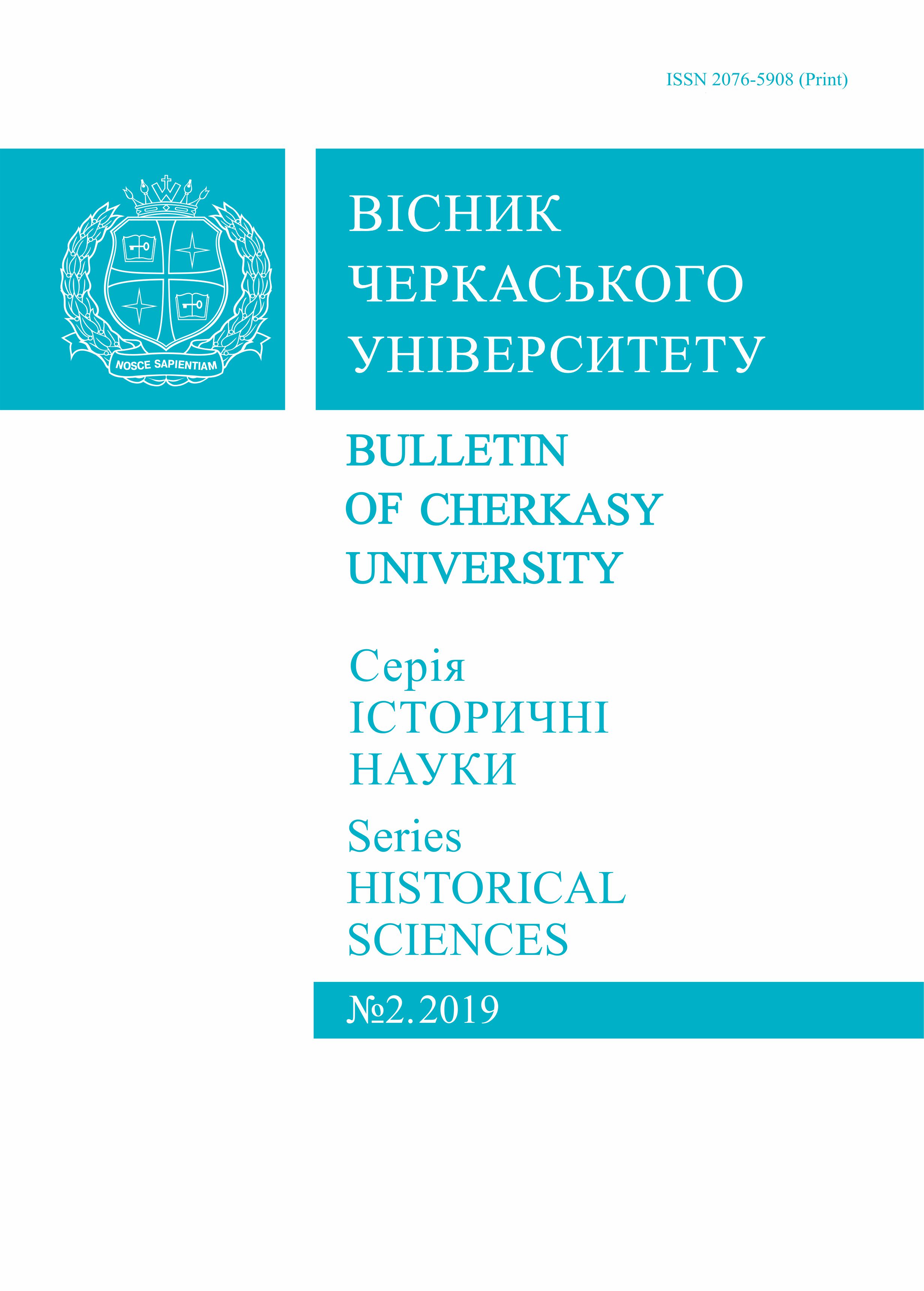Source base of studying the Eastern Slavs’ Ethnic History: the experience of contemporary Belarusian historiography
##plugins.themes.bootstrap3.article.main##
Анотація
Introduction. The problems of the Eastern Slavs’ ethnic history, like any other historical problem, can be clarified only through a representative source base and successful theoretical equipment of such ethnoistoric research. The purpose of the article is to analyze the validity of the source base at the present stage, which should provide the ethno-historical reconstruction of the East Slavs’ communities’ formation and development at the pre-Mongol era in the contemporary Belarusian historiography framework.
Results. Most contemporary Belarusian scientists, in their attempts to reconstruct both the general ethnogenesis of Slavs and the formation of East Slavic ethnic communities, not only ignore the existing historiography of these aspects of the past researching, but also have a rather superficial approach to the analysis of its source aspect. The only one who paid attention to the review of the early Middle Ages history sources, though not specifically about the ethnic history of the Eastern Slav communities, in contemporary Belarusian historiography is the historian S. Temushev.
The analysis of the source base of modern Belarusian specialists’ works, who offer their own versions of reconstruction the Slavs ethnic history, convinces us that most of them are based on archaeological sources. At the same time, specialists are well aware of their limitations in ethnological reconstructions. However, archeologists do not stop trying to construct their own ethnohistoric scheme relative to Slavic ethnogenesis, that is shown, for example, by the creativity of E. Zagarulski.
Does not add the optimism the level of textual analysis of the written sources within the modern Belarusian historiography of the Eastern Slavs ethnic history limits. It is also characterized by superficial reviews of problem places in chronicles and the application of outdated techniques in their interpretations. There is search for “sensations” in the modern Belarusian humanitarian discourse in the form of denial of the ancient Russian chronicle authenticity. On the other pole of the problem is the positivist directness of reading “The Tale of Bygone Years”, as a result its author is credited with almost modern diploma of ethnologist.
Conclusion. The contemporary Belarusian historiography of the problem of the Eastern Slavs ethnic history can’t yet boast by a serious source aspect of its development.
##plugins.themes.bootstrap3.article.details##
Посилання
Ivangorodsky, K. (2018). Sourcing aspects of the reconstruction of the East-Slavs ethnic history in the contemporary Ukrainian historiography. Bulletin of Cherkasy University, History Series, 3-4, 5-16. (in Ukr.)
Ivangorodsky, K. (2015). Belarusian historiography today: between neo-Soviet and national practices. In: V. Masnenko (ed.). The Image of Belarus in historiography and historical memory of Ukrainians: collective monograph, 31–63. Cherkasy. (in Ukr.)
Source Studies: Theory. History. Method. Sources of Russian history (1998). Moscow. (in Russ.)
Rassadin, S. E. (2008). First Slavs. Slavs-genesis. Minsk. (in Russ.)
Pilipenko, M. F. (1991). The Emergence of Belarus: a new concept. Minsk. (in Russ.)
Rogalev, A. F. (1994). Belaya [White] Rus and Belarusians: in search of origins. Homel. (in Russ.)
Mіkulіch, T. M. (1996). Language and ethnic identity. Minsk. (in Belar.)
Temushev, S. N. (2008). The Origin of Rus’: the Genesis of Statehood in Sources and Historical Traditions. Minsk. (in Russ.)
Temushev, S. N. (2014). Formation of the Old Rus’ State. Moscow. (in Russ.)
Egoreichenko, A. A. (2006). Cultures of hatched ceramics. Minsk. (in Russ.)
Medvedev, A. (2004). The population of Central and Eastern Belarus during the Great Migration. In: A. Egoreichenko (ed.). Eastern Europe in Antiquity and the Middle Ages, 37-45. Minsk. (in Russ.)
Makushnikov, O. A. (2009). Homel-Dniepr-region in the V – mid. XIII centuries: socio-economic and ethnocultural development. Homel. (in Russ.)
Lysenka, P. (2000). Introduction. In: Archeology of Belarus in 4 vol., vol. 3: The medieval period (IX - XIII cc.), 5-9. Minsk. (in Belar.)
Lysenko, P. F. (1999). Land of Turov. IX – XIII centuries. Minsk. (in Russ.)
Shadyro, B. (1998). The role of European ethno-cultural processes I millennium AD. in the ethnogenesis of the Belarusians. In: A. Egoreichenko (ed.). Slavs and their neighbors: archeology, numismatics, ethnology, 86-90. Minsk. (in Belar.)
Shadyra, V. I. (2006). Belarusian-Dvina-region (I millennium AD). Minsk. (in Belar.)
Zagorulsky, E. M. (2012). Slavs: origin and settlement in Belarus. Minsk. (in Russ.)
Egareychanka, E., Shadyra, V., Viargey, V. et al. (1999). Archeology of Belarus in 4 vol., Shadyra, V., Viargey, V. (ed.). Vol. 2: Iron Age and early medieval. Minsk. (in Belar.)
Miadz’viedziev, A. (1994). The population of Belarus in the Iron Age (VIII c. BC E. – VIII c. AD). Belarusian historical review, vol. 1, 15-37. Minsk. (in Belar.)
Bahdanovich, A. (2005). Source study aspects of the study of ethnic identity of Belarusians in the Middle Ages. A source study and special historical disciplines, vol. 2, 145-148. Minsk. (in Belar.)
Ilyin, A. (2011). “The Tale of Bygone Years” and the questions of Belarusians ethnogenesis. Dedy [Grandfathers]: digest of publications on Belarusian history, 6, 99-112. Minsk. (in Russ.)
Demin, V. N. (1996). Philosophical principles of Russian cosmism. Thesis of PhD. Moscow. (in Russ.)
Pilipenka, N. (2000). Formation of Rus’. In: Abramov, F. (et al.). Belarus at the turn of the millennium, 30-43. Minsk. (in Belar.)
Kalakura, Ya., et al. (2002). Historical Source Studies: A Textbook. Kyiv: Lybid. (in Ukr.)
Goehrke, C. (1992). Frühzeit des Ostslaventums. Darmstadt: Wissenschaftliche Buchgesellschaft.
Danilevsky, I. (1998). Historical sources of the XI–XVІІ c. In: Source Studies: Theory. History. Method. Sources of Russian history, 171-317. Moscow. (in Russ.)
Tolochko, A. (2015). The essays of primary rus. Kyiv; St. Petersburg. (in Russ.)
Stefanovich, P. (2012). “The Legend of the Calling of the Varangians” or Origo gentis russorum? In: Melnikova, E. (ed.). The oldest states of Eastern Europe. 2010: Background and ways of formation of the Old Russian state, 514-583. Moscow. (in Russ.)

